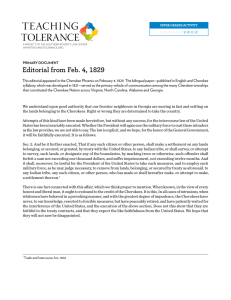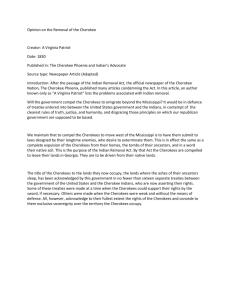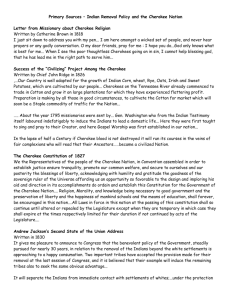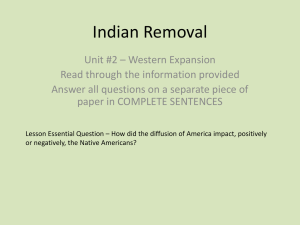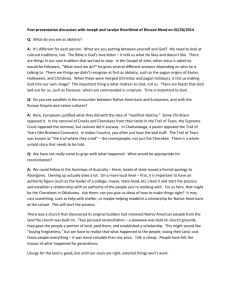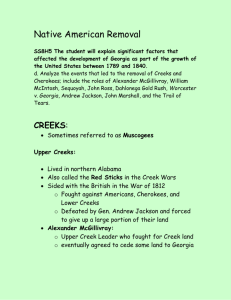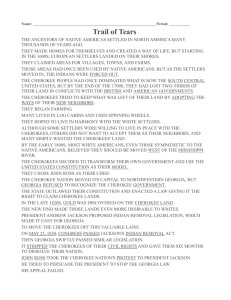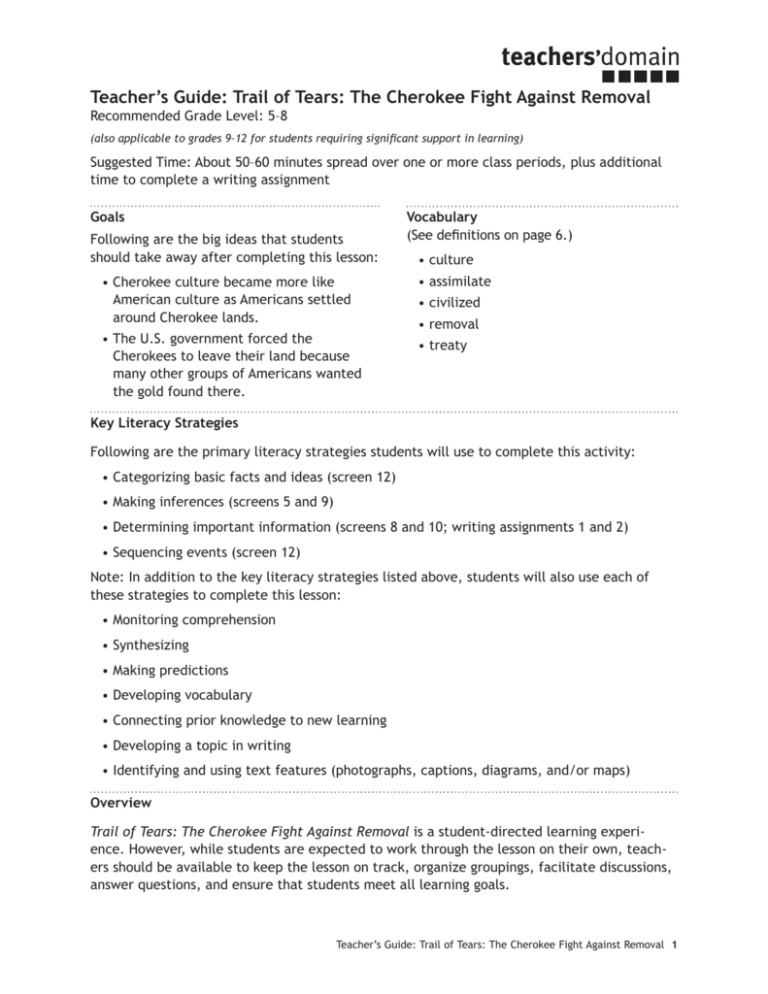
Teacher’s Guide: Trail of Tears: The Cherokee Fight Against Removal
Recommended Grade Level: 5–8
(also applicable to grades 9–12 for students requiring significant support in learning)
Suggested Time: About 50–60 minutes spread over one or more class periods, plus additional
time to complete a writing assignment
Goals
Following are the big ideas that students
should take away after completing this lesson:
Vocabulary
(See definitions on page 6.)
• culture
•Cherokee culture became more like
American culture as Americans settled
around Cherokee lands.
• assimilate
•The U.S. government forced the
Cherokees to leave their land because
many other groups of Americans wanted
the gold found there.
• treaty
• civilized
• removal
Key Literacy Strategies
Following are the primary literacy strategies students will use to complete this activity:
• Categorizing basic facts and ideas (screen 12)
• Making inferences (screens 5 and 9)
• Determining important information (screens 8 and 10; writing assignments 1 and 2)
• Sequencing events (screen 12)
Note: In addition to the key literacy strategies listed above, students will also use each of
these strategies to complete this lesson:
• Monitoring comprehension
• Synthesizing
• Making predictions
• Developing vocabulary
• Connecting prior knowledge to new learning
• Developing a topic in writing
• Identifying and using text features (photographs, captions, diagrams, and/or maps)
Overview
Trail of Tears: The Cherokee Fight Against Removal is a student-directed learning experience. However, while students are expected to work through the lesson on their own, teachers should be available to keep the lesson on track, organize groupings, facilitate discussions,
answer questions, and ensure that students meet all learning goals. Teacher’s Guide: Trail of Tears: The Cherokee Fight Against Removal 1
The following is a summary of the lesson screens:
Screen 1: Students learn that the Cherokee nation was threatened by American settlement in 1828 and ask themselves what the Cherokees will do.
Screen 2: Students read about the Cherokees, where they lived, and how they adopted
an assimilation strategy that led Americans to see them as “one of the civilized
tribes.”
Screen 3:
Students learn what the goals are for the lesson, which strategies they will be
using to complete the lesson, and the important vocabulary words they will use
during the lesson.
Screen 4:
Students read about elements of Cherokee culture before and after assimilation.
Screen 5:
Students read about how most Native Americans did not have a system of writing and how a Cherokee named Sequoyah created a Cherokee alphabet. They
watch a video describing its impact and then write down how this alphabet
changed the Cherokee way of life.
Screen 6:
Students read about the successful aspects of the Cherokee assimilation
strategy.
Screen 7:
Students read about how the discovery of gold on Cherokee lands led President
Andrew Jackson to issue the Indian Removal Act in 1830. They then explain
what was the purpose of the Indian Removal Act.
Screen 8: Students answer three multiple-choice questions to show their comprehension
of the Cherokee assimilation strategy and how the discovery of gold affected
Cherokee hopes of keeping their land.
Screen 9: Students read a PDF text that describes how the Cherokees assimilated American culture, and how they fought the Indian Removal Act with one strategy
they had assimilated—fighting in court. Then they write their thoughts on why
the Cherokee assimilation strategy failed to keep them safe.
Screen 10: Students watch a video showing a reenactment of the Indian Removal Act being
put into effect. The Cherokees were driven from their homes and sent out on
the Trail of Tears, where hundreds died of exposure, fatigue, and grief. Students can view a map that shows the three routes taken by the Cherokees on
the Trail of Tears. They then write a brief description of what happened to the
Cherokees in 1838 after the federal government forced them off of their land.
Screen 11: Students complete an interactive vocabulary activity, and then choose two
words from the vocabulary list and write a new sentence for each word. These
tasks demonstrate their understanding of the meanings of the words.
Screen 12: Students use an interactive activity to sort events in the Cherokee story into
specific categories ranging from their early assimilation to removal from their
land.
Final
Assignment: Students select and complete a writing assignment about the lesson topic.
Teacher’s Guide: Trail of Tears: The Cherokee Fight Against Removal 2
Before the Lesson
q Go through each screen of the lesson, including all the interactive activities, so that you
can experience ahead of time what students will be doing. As you go through each screen,
jot down your own expectations for students’ responses. q Determine if students will be working individually or in pairs on the lesson. Some students
may be able to work independently with little or no support. Students who are less familiar
with the subject area or who struggle with literacy skills may benefit from working with
another student. An effective way to do this is to pair a stronger student with a less able
reader. You can also have students work individually on certain tasks and in pairs on others,
depending on their experience and needs. If students will be working in pairs on any portion of the lesson, let them know if they will be expected to type in their notes individually
or together.
q Provide instruction on key vocabulary (vocabulary words are defined in the lesson on screen
3, and on page 6 of this guide). q Determine what students already know about the Cherokees or the Trail of Tears, and offer
a brief overview of the Cherokee story. Record their ideas on a chart. This will give you a
sense of students’ possible misconceptions and the background knowledge they have before
beginning this lesson. If time allows, return to the chart after students have completed the
lesson to add new learning and correct misconceptions. Note: You may want to record their
new learning in a different-colored ink so they can see how much they’ve learned.
qArrange computers with Internet access so students can work individually or in pairs.
q Before students begin, suggest a timeline for completing the lesson, mention the different types of media they will encounter, and let them know how you expect them to submit
their work. You may want to provide an outline of this information on a chart, chalkboard,
or whiteboard, or as a handout.
Lesson Assessments
The following are descriptions of the lesson features that will be part of the packet of materials that students will submit. Students will use the packet for reference when writing their
final assignment. It also serves as a formative assessment tool to monitor students’ work as
they are progressing through the lesson.
• Notes – Students write brief responses to questions on screens 5, 7, 9, and 10. If time
allows, review their notes before students begin their writing assignment.
• Multiple-choice questions – Students complete the three multiple-choice questions on
screen 8. Walk around to make sure students answer all three questions before they
continue. If students click to go to the next page before they finish, their work will not
be saved.
• Match It! – Students complete an interactive vocabulary activity on screen 11. They
begin by dragging the vocabulary terms into the correct sentences. After they finish and
save their work, they will be able to check their answers against an answer key. When
Teacher’s Guide: Trail of Tears: The Cherokee Fight Against Removal 3
they are done, they will be asked to choose two vocabulary words and write a new sentence for each word. Sentences should demonstrate a clear understanding of the meaning of each word. An inappropriate response would be “Cherokees used assimilation.” An
appropriate response would be “The Cherokees adopted parts of American culture as an
assimilation strategy.”
• Arrange It! – Students complete the comprehension activity Arrange It! on screen 12.
Students will sort information on a concept map to describe different events in the
Cherokee story. Students will not be able to check their answers online, so you will need
to provide them with correct answers when they are finished with the lesson. You can
choose to review the answers as a class or return the corrected packet of materials to
students before they begin the final assignment.
Following are the descriptions students will drag and drop onto the concept map in the
appropriate category:
How the Cherokees Assimilated
• Cherokees lived on American-style farms
• Cherokees became Christians
• Cherokees learned English
• Cherokees created an alphabet for their language How the U.S. Attacked the Cherokees
• 1830 Indian Removal Act was passed
• The state of Georgia started taking Cherokee land
How the Cherokees Fought Removal
• Cherokees protested to Congress
• Cherokees appealed to the U.S. Supreme Court
How the Conflict Ended
• Cherokees were forced from their homes by the U.S. Army
• U.S. soldiers forced the Cherokees to march to Oklahoma
• Cherokees resettled in Oklahoma
• Thousands of Cherokees died on the march—the Trail of Tears
• Final Assignment – Students complete one final writing assignment. You can choose to let
students make their own selection, or assign one according to your goals for the lesson.
Use the rubric on page 7 to assess the writing assignments. Lesson Aids and Extensions
Use the following suggestions to help students if they are stuck on a particular screen, as
follow-up discussions to reinforce learning, and to prepare students for completing their writing assignments.
•Watching Videos – Encourage students to watch the videos more than once. After the initial viewing, provide students with a specific content focus to frame their next viewing(s)
Teacher’s Guide: Trail of Tears: The Cherokee Fight Against Removal 4
of the video. This will help them draw connections between the main topic and the
information that the videos have to offer. To learn more about best practices for viewing
videos in the classroom, check out Effective Video-Based Lessons (http://www.teachersdomain.org/resource/vtlpd.pd.hints.frfofo/).
•Participating in Discussions – Organize class discussions or encourage students to talk
about their questions in pairs. You may want to use the following discussion starters:
o Why did the Cherokees want to stay on their land?
o Why was the discovery of gold on their land so important to the Cherokee history?
o How do you think most Americans felt about the Trail of Tears at the time? How do
you feel about it now?
oWhy did white Americans initially think of the Cherokee as a “civilized tribe”?
oWhy do you think the Cherokee people did not win their fight against the government to keep their land?
•Reading the PDF Text – Before they read the PDF text on screen 9, ask students to make
predictions about how the Cherokees would respond to the Indian Removal Act.
•Sharing Student Work – It may be motivational, and a further learning opportunity, for
students to post their final essays so that their classmates, peers, and/or parents can see
them. This may also provide an opportunity for students to comment on and discuss each
other’s essays.
If you do not already have access to an online writing community, Teaching MattersTM
provides TeXT, free classroom publishing tools that allow teachers and students to create
and publish their own online eZine. More information and a free signup are available at
Teaching Matters: TeXT (http://text.teachingmatters.org). •Reflection and Self-Assessment – After students have turned in their writing assignments, you can choose to have them assess their learning. Bring students together as a
whole class or in small groups to discuss the questions below. You may want to return to
the chart of their ideas developed before the lesson and record their new learning. You
may also have students respond individually to the questions, and then convene the class
to discuss the chart.
oWhat did you learn?
oWhat was surprising?
oWhat questions do you still have?
oWhat was the easiest for you to understand and do?
oWhat was the most difficult?
Teacher’s Guide: Trail of Tears: The Cherokee Fight Against Removal 5
Vocabulary Definitions
assimilate
To successfully adopt parts of another culture into your own.
civilized
People with a written language and complex systems of religion and government. Most Americans thought Native Americans were not civilized because few Native groups had a system of
writing and their religions and government were so different from other American versions.
culture
The behaviors and beliefs of a group of people. Culture includes clothing styles, food, social
customs, ways of speaking, and religious practice.
removal
To force a group of people to go from one location to another.
treaty
A written agreement between two or more groups.
Teacher’s Guide: Trail of Tears: The Cherokee Fight Against Removal 6
Provides an adequate response
to the question. Topic and ideas
are generally well organized,
with two relevant supporting
details from the reading passage, video, and other materials
in the lesson.
Uses two vocabulary words (or
a form of the vocabulary words)
from the lesson, and uses them
both correctly.
Provides a clear and accurate
response to the question. Ideas
are elaborated, with three or
more relevant supporting
details from the reading passage, video, and other materials
in the lesson.
Uses at least three vocabulary
words (or a form of the vocabulary words) from the lesson, and
uses them all correctly.
3
4
Does not use any vocabulary
words, or uses vocabulary
words incorrectly.
Provides an inaccurate
response to the question or
fails to address the question.
May include misinterpretations.
Understanding of the topic is
not apparent.
1
Teacher’s Guide: Trail of Tears: The Cherokee Fight Against Removal 7
Uses one vocabulary word (or
a form of the vocabulary word)
from the lesson, and uses it
correctly.
Provides a generally accurate
response, with one supporting
detail from the reading
passage, video, and other
materials in the lesson.
2
2. You are a Cherokee chief in 1831. Write a letter to the U.S. Supreme Court arguing why the Cherokees should be able to
remain on their land.
1. In your own words, describe how the Cherokees changed their culture in order to stay on their land. Then explain why
they ended up losing their land even with these changes.
Final Assignment Rubric
Trail of Tears: The Cherokee Fight Against Removal
Scoring the Rubric
Here are two suggestions for scoring the final assignment rubric. Select the option that best
meets your needs or develop your own grading system.
Option 1: This option provides one score for each submitted assignment.
Assign a score of 4 or below for the written response (first row of the rubric) and a score of 4
or below for the use of vocabulary (second row of the rubric), for a total maximum score of 8.
The interpretation of scores is as follows:
Score
Grade
Narrative Interpretation
7-8
A
Excellent
5-6
B
Good
4
C
Adequate (Fair)
3 or below
D
Minimal
Option 2: This option provides two scores for each submitted assignment: one for written
content and one for the use of key vocabulary. An advantage of separate scores is that you
can weight students’ comprehension and composition differently than you do their knowledge
of vocabulary. It can also help you identify specific needs for future instruction.
Assign a score of 4 or below for the written response (first row of the rubric) and a score of 4
or below for the use of vocabulary (second row of the rubric) and then score them separately.
The interpretation of scores is as follows:
Score
Grade
Narrative Interpretation
4
A
Excellent
3
B
Good
2
C
Adequate (Fair)
1
D
Minimal
The final grade may look like this: A/B (A for content and B for vocabulary use).
©2011 WGBH Educational Foundation. All Rights Reserved.
Teacher’s Guide: Trail of Tears: The Cherokee Fight Against Removal 8


